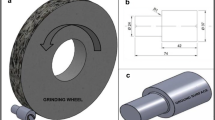Abstract
The performance of cutting tools can be drastically affected by cutting edge preparation i.e. the presence of a radius and/or a chamfer and their dimensions can alter cutting forces and temperature and, consequently, tool life as well as the surface quality of the machined component. The aim of this work is to investigate the machinability of AISI 4140 steel hardened to 40 HRC and 50 HRC when turning with coated tungsten carbide inserts with various microgeometries (brushed edges with distinct slopes). The following aspects were considered: cutting force components, cutting temperature and machined surface roughness. In comparison with the published literature, the novelty of the present work is related to the investigation of the machinability of a hardened steel by applying a large variety of customized non-commercial cutting edge geometries. Differently from other studies, the paper presents experimental results for temperature in the contact zone employing different cutting edge geometries. Moreover, in order to explain the results, an analysis of tool-workpiece contact zone is carried out for each edge geometry. The results indicated that cutting edge microgeometry affects mainly the feed and passive force components, while the cutting force, specific energy and cutting temperature are not drastically altered. Finally, no clear relationship between microgeometry and machined surface roughness was noticed, although irregular marks on the roughness profile were found when sharp edges were used (suggesting edge chipping) and evidence of side flow was noted when rounded edges were tested.
Similar content being viewed by others

References
Benlahmidi S, Aouici H, Boutaghane F, Khellaf A, Fnides B, Yallese MA (2016) Design optimization of cutting parameters when turning hardened AISI H11 steel (50 HRC) with CBN7020 tools. Int J Adv Manuf Technol. doi:10.1007/s00170-016-9121-3
Tang L, Gao C, Huang J, Lin X, Zhang J (2014) Experimental investigation of the three-component forces in finish dry hard turning of hardened tool steel at different hardness levels. Int J Adv Manuf Technol 70:1721–1729
Yussefian NZ, Koshy P, Buchholz S, Klocke F (2010) Electro-erosion edge honing of cutting tools. CIRP Annals – Manuf Technol 59:215–218
Aurich JC, Zimmermann M, Leitz L (2011) The preparation of cutting edges using a marking laser. Prod Eng Res Devel 5:17–24
Fernández-Abia AI, Barreiro J, López de Lacalle LN, González-Madruga D (2014) Effect of mechanical pre-treatments in the behaviour of nanostructured PVD-coated tools in turning. Int J Adv Manuf Technol 73:1119–1132
Sharma V, Pandey PM (2016) Geometrical design optimization of hybrid textured self-lubricating cutting inserts for turning 4340 hardened steel. Int J Adv Manuf Technol. doi:10.1007/s00170-016-9163-6
Thiele JD, Melkote SN (1999) Effect of cutting edge geometry and workpiece hardness on surface generation in the finish hard turning of AISI 52100 steel. J Mater Process Technol 94:216–226
Meyer R, Köhler J, Denkena B (2012) Influence of the tool corner radius on the tool wear and process forces during hard turning. Int J Adv Manuf Technol 58:933–940
Chinchanikar S, Choudhury SK (2016) Cutting force modeling considering tool wear effect during turning of hardened AISI 4340 alloy steel using multi-layer TiCN/Al2O3/TiN-coated carbide tools. Int J Adv Manuf Technol 83:1749–1762
Özel T (2003) Modeling of hard part machining: effect of insert edge preparation in CBN cutting tools. J Mater Process Technol 141:284–293
Denkena B, Lucas A, Bassett E (2011) Effects of the cutting edge microgeometry on tool wear and its thermomechanical load. CIRP Annals – Manuf Technol 60:73–76
Kurt A, Şeker U (2005) The effect of chamfer angle of polycrystalline cubic boron nitride cutting tool on the cutting forces and the tool stresses in finishing hard turning of AISI 52100 steel. Mater Des 26:351–358
Chen L, El-Wardany TI, Nasr M, Elbestawi MA (2006) Effects of edge preparation and feed when turning hard turning a hot work die steel with polycrystalline cubic boron nitride tools. CIRP Annals - Manuf Technol 55:89–92
Davoudinejad A, Noordin MY (2014) Effect of cutting edge preparation on tool performance in hard-turning of DF-3 tool steel with ceramic tools. J Mater Process Technol 28:4727–4736
Khalili K, Safaei M (2009) FEM analysis of edge preparation for chamfered tools. Int J Mater Form 2:217–224
Denkena B, Köhler J, Mengesha MS (2012) Influence of the cutting edge rounding on the chip formation process: part 1. Investigation of material flow, process forces and cutting temperature. Prod Eng Res Devel 6:329–338
Denkena B, Biermann D (2014) Cutting edge geometries. CIRP Annals – Manuf Technol 63:631–653
Basset E, Köhler J, Denkena B (2012) On the honed cutting edge and its side effects during orthogonal turning operations of AISI 1045 with coated WC-Co inserts. CIRP J Manuf Sci Technol 5:108–126
Author information
Authors and Affiliations
Corresponding author
Rights and permissions
About this article
Cite this article
Ventura, C.E.H., Chaves, H.S., Campos Rubio, J.C. et al. The influence of the cutting tool microgeometry on the machinability of hardened AISI 4140 steel. Int J Adv Manuf Technol 90, 2557–2565 (2017). https://doi.org/10.1007/s00170-016-9582-4
Received:
Accepted:
Published:
Issue Date:
DOI: https://doi.org/10.1007/s00170-016-9582-4


